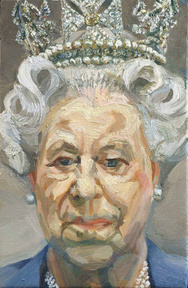On all sorts of decline – Craig Raine in TLS:
‘Everyone interested in Lucian Freud will want to see the National Gallery’s exhibition, modest, limited even, as it is – five rooms, thematically arranged, to commemorate the centenary of his birth – where the greatest thing is a small incomparable watercolour of his mother’s head. The expression of quizzical alertness in the eyes matches her mouth. The hair is brilliant, too: fifty shades of grey. Otherwise, so many suited people, outnumbering the nudes, nudes safely apportioned between the sexes. The nudes have been subtly weeded. A note of wariness, of reservation, of moral distancing, of pudeur, is audible in the catalogue. The tendency to restrict the identity of nude female sitters to the role of Muse and ignore their professions and capabilities is spelt out: “This important criticism of a male gaze …”. I don’t know that anything of substance is added, say, by the title “Benefits Supervisor Sleeping”. And there is downright hostility in scathing quotations from the feminist art historian Linda Nochlin. (The best essay is by a grateful, slightly awed Nicholas Penny, who managed to secure for the Ashmolean “Small Naked Portrait” (1973–4) of Jacquetta Eliot, having first failed to acquire “Two Japanese Wrestlers by a Sink” (1983–7).) The wider arc of Freud’s career is obscured here by the unchronological hang.
His biographer William Feaver says that Freud’s portrait of the Queen, on show here, “wasn’t so different from the 1952 head of Francis Bacon”. Both are small. Both are painted close to. Bacon and Freud sat with their knees practically touching – not the case with Her Majesty. Both required many sittings. The royal portrait took a year, the Bacon two or three months. The Queen was captured on canvas, Bacon on a copper plate. And there is something copperplate about the Bacon portrait – meticulous, controlled, uniform, classical, a brilliant exercise in Ingres detail and finish. Part of the portrait’s power is the way it fills the space exactly, so the impression of mass is created, though the painting is small, cognate, you might say, with an Elizabethan miniature, a Nicholas Hilliard or an Isaac Oliver. The finish is quasi-enamel. It resists revealing its process.’
(…)
‘As Freud said repeatedly, human beings are only animals with clothes on. In the painting this implicit truth isn’t a matter for remark, for exclamation. It is a matter of fact. And this is a painting of quiet desolation, from which love and enchantment have gone. The mattress ticking takes us back to basics, to things stripped bare, to lovelessness. The marriage is over.’
(…)
‘This is a common criticism of Freud’s nudes – that they are pitiless and misogynist. I think these criticisms are fundamentally sentimental and in denial. I set against them a remark of Freud’s quoted in Volume Two of Feaver’s biography: “I’m so fond of navels”. To anyone who isn’t disabled by prudery, Freud’s interest in genitals, in nipples, in belly-buttons, in bodies, is perfectly normal. No one is not interested. No one. Prudes are particularly interested and exercised. Intensity of attention is a manifestation of love. Careful scrutiny is full of caring. Or, in a favourite Freud quotation from Ortega y Gasset: “Love is a phenomenon of attention”. In his interview with Sebastian Smee in Freud at Work (2006), Freud defines love: “I’m talking about actual, complete, absolute concern, where everything about the other person interests, worries or pleases you.” (…)
‘He disliked being compared to Egon Schiele. In conversation with Smee he put his objection to Schiele paradoxically: “They are all these organs and sexual parts, and yet you just jolly well don’t know what gender they are.” He means by this, I think, that Schiele’s bodies are unisex, gaunt fashion drawings, stylized and formulaic, insignificant in themselves, merely sites for sexual organs. Freud professed to see a “kind of affectation”, “the desire to shock”, “artiness” – qualities that Schiele, he thought, shared with Klimt.’
(…)
‘The painting of the Duke of Devonshire (“Portrait of a Man”, 1971–2) depicts the Duke as a depressed alcoholic with a comb-over, shirt collar slightly askew, looking hopelessly down. Brilliantly, the bulk of the painting is the Duke’s charcoal suit, a wasteland of differentiated greys. And the forehead prefigures that of Auerbach three years later. It shares its shadowing and modelling, while the paintings are fundamentally differentiated in their other particulars. It is my favourite Freud.’
(…)
‘The nature of the decline? To do, I think, with Freud’s eyesight. He did his etchings with spectacles, but painted without.’
Read the article here.
It’s bit unfair about what’s being said here about Schiele, but I’m not an art critic.
It’s hard not be charmed by anybody who says ‘I’m so fond of navels’. On the other hand the, hangman and the torturer might be full of attention also. It's a bit an exaggeration to call this attention love.
Desire and interest go hand in hand, and the more appealing desire is always embedded in reality, decline and repulsion are part of the desire.
A painting of a depressed alcoholic as the ‘favorite Freud’ – now that’s a man with whom I can have a conversation.
